Editors of this issue: Bronius Vaskelis

|
LITUANUS
LITHUANIAN QUARTERLY JOURNAL OF ARTS AND SCIENCES
Volume 20, No.1 - Spring 1974
Editors of this issue: Bronius Vaskelis Copyright © 1974 LITUANUS Foundation, Inc.
|

|
JURGIS BALTRUŠAITIS
A Lithuanian and Russian Symbolist 1873-1944
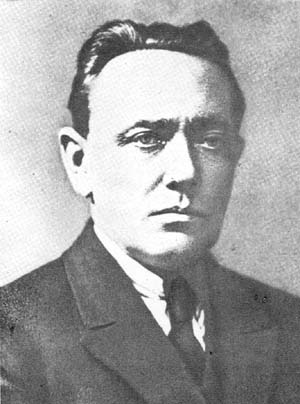 |
|
Jurgis Baltrušaitis in 1929 |
In commemoration of the thirtieth anniversary of Jurgis Baltrušaitis' death, this entire issue is devoted to introducing his works to the English-speaking world. As a writer he belongs to the literature of two nations, the Russian and the Lithuanian. Since he is known only to a few, especially in Western literary circles, we fell compelled to offer what is hoped are representative examples of his work in poetry, prose and literary criticism.
It is known that in his student days Baltrušaitis' first attempt in composing poetry was made in Lithuanian.1 For unknown reasons, however, he soon chose to use only the Russian language for his literary endeavors. Early in his career he began to translate into Russian the works of Maurice Maeterlinck, Henrik Ibsen, Giovanni d'Annunzio, Gerhart Hauptmann, August Strindberg, Oscar Wilde and since 1899 his poetry began to appear in Russian. At the turn of the century he became acquainted with leading Russian symbolists, some of whom became his close friends. During his relationship in the publishing house of "Skorpion" and also while a member of the editorial board of the symbolist review "Vesy", he developed a very personal and literary relationship with Konstantin Balmont and Valery Briusov. In the second decade of the twentieth century Viačeslav Ivanov was one of Baltrušaitis' literary companions and it seems that the latter shared some of the former's belief on poetry and the duty of a poet.
The symbolist movement in Russian literature reveals the vitality of its participants and the diversity of their interests and attitudes toward symbolism in general. The Symbolist writers distinguished themselves by their inconsistency because of their radically shifting opinions during the period from 1894 to 1910 when symbolism dominated the Russian literary scene. Throughout that period Baltrušaitis was an active participant, but at the time he can hardly be said to have exhibited the same variable, mercurial traits. He never expressed any strong views during their literary and ideological discussions. This was due partly to his frequent and prolonged sojourns between 1900 - 1913 in Italy, Switzerland and other Western European countries and partly because Baltrušaitis attached no significant value to any literary school or group.
His literary works show no distinct change of attitude toward the use of literary devices; instead they represent a rather gradual development from the beginning to the end in the realm of his aesthetic beliefs and poetic techniques. Baltrušaitis was probably one of the most consistent of Russian symbolists.
The First World War completely changed Baltrušaitis' life in regard to his personal and literary activities. After the German invasion of Lithuania in 1915, many Lithuanians fled to Russia, and a considerable number of them settled in Moscow. We see Baltrušaitis helping his compatriots, for example, working on the Committee for Lithuanian War Refugees or helping students enter the university. This renewal of a relationship with his compatriots which had been discontinued in his teens, influenced the future activities of Baltrušaitis. From 1917 to 1920 he devoted his time and energy to two worlds: the Lithuanian and the Russian. With the former, his ties became stronger and more intimate, whereas with the latter, he continued social and cultural relationships. After his appointment in 1920 as a Lithuanian envoy to the Soviet Union, he ceased to be an active participant in Russian social and literary activities; however, he maintained personal contact with his Russian friends. Within a few years time Baltrušaitis' name as a poet disappeared from the Soviet press, and it was not mentioned even in studies devoted to Russian Symbolism.
Just when Baltrušaitis again began writing poetry in Lithuanian is difficult to ascertain. He often told his Lithuanian friends that he began to write in Lithuanian after 1905, but to date there is nothing to substantiate this claim. His first poem in Lithuanian was written and published in 1927. At present we know of only eight poems that were written in Lithuanian between 1927 and 1939. The vast majority of Baltrušaitis' Lithuanian poetry was written after his retirement from the diplomatic service in 1939 when he lived in Paris.
The occupation of Lithuania first by the Soviet Union (1940) and then by Germany (1941) made it difficult for Baltrušaitis' poetry to reach his native country. Nevertheless, his collection of poems, Ašarų vainikas (The Wreath of Tears) was smuggled from France into Lithuania and published in 1942. Due to post war Soviet literary policies, Baltrušaitis as a poet was completely ignored in the literary history of Lithuania for almost 20 years.
In the sixties Baltrušaitis was apparently "rehabilitated". At first his name was mentioned from time to time in the press. Then several articles on his life and work appeared. No doubt, the biggest event in Baltrušaitis' revival was the publication of his Lithuanian and Russian poetry in his native country (See the review in this issue of Lituanus). Baltrušaitis" poetry was very favorably reviewed in both Lithuanian and Russian Periodicals; the collections of his poetry sold out within a few weeks.
At present Baltrušaitis enjoys a definite renaissance in Lithuania. The centennial of Baltrušaitis' birth and the thirtieth anniversary of his death, for example, received a great deal of attention from the Soviet regime. On this occasion numerous articles about the poet were published. Several exhibits of Baltrušaitis' work, public commemorations and recitals of his poetry have been organized in Vilnius and Kaunas.
Baltrušaitis is primarily a poet. Nevertheless, he wrote several short stories, literary articles and reviews on Russian as well as on European writers. His poetry speaks in many moods and states of mind. In order to understand and to fully enjoy his poetry or that of any other symbolist writer it is necessary to have a certain knowledge of his views on life and art. These views are best expressed in Baltrušaitis' articles and reviews.
In organizing this issue, therefore, the selections have been made to provide not only the representative samplings of Baltrušaitis' creative activities, but his aesthetic views as well. The articles and reviews have been taken from Russian journals and literary reviews and all of them appear in English for the first time.
The essay "On the Essence of Art and the Creative Duty of the Artist," originally delivered as a lecture to a Russian audience in Moscow (1915), remained as a manuscript; it later appeared translated and published in Lithuanian. Baltrušaitis' views on pictorial art are expressed in the article "The Distinguishing Inner Marks of Reorich's Painting". These views are very similar to those found in Baltrušaitis' voluminous still unpublished correspondence with his literary friends. Baltrušaitis' essay "To the Memory of Emile Verhaeren", written a few days after the death of this Belgian poet, present Baltrušaitis' views on modern poetry as well as the role of the poet in the twentieth century.
It is regrettable that the short story "Legend of the Torches" does not provide the best sampling of Baltrušaitis' prose. His other stories are too long for inclusion in this issue.
Delija J. Valiukėnas' article "Jurgis Baltrušaitis and William Blake: A Brief Comparison" places Baltrušaitis in a better perspective. Valiukėnas' article as well as this issue of Lituanus would hopefully provide an impetus for readers to become better acquainted with Baltrušaitis' work.
B. V.
1 For J. Baltrušaitis' biography and analysis of his work see B. Vaškelis' article "Jurgis Baltrušaitis: A Lithuanian and Russian Symbolist," Lituanus, Vol. 10, No. 3-4, Fall-Winter, 1964.
JURGIS BALTRUŠAITIS
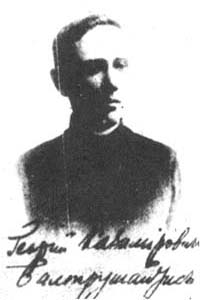
|
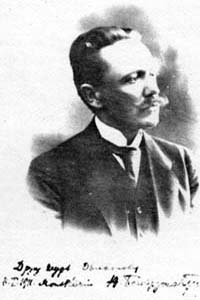
|
|
Circa 1890
|
Circa 1911
|
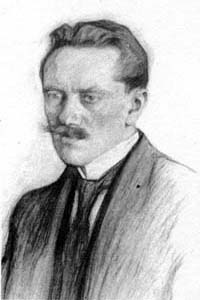
|
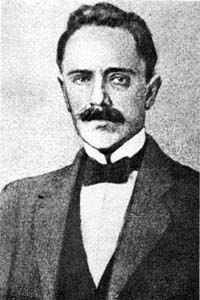
|
| Circa 1912 | Circa 1914 |
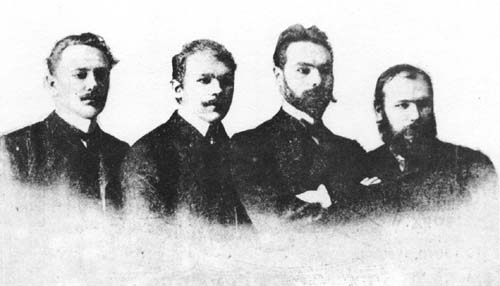
Partners of the Publishing House "Skorpion" J. Baltrušaitis, M. Semenov, V. Briusov and S. Poliakov.
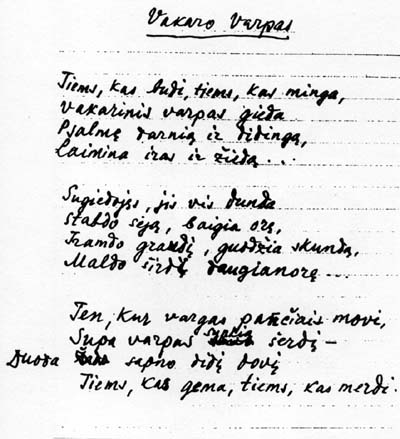
Facsimile of Baltrušaitis' handwriting The Poem "Vakaro Varpas"
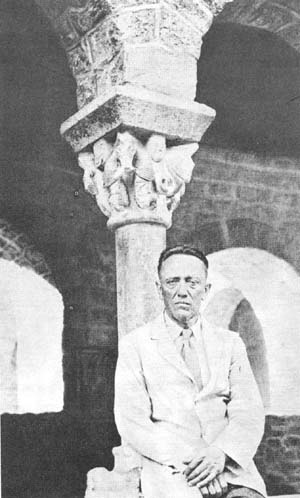
One of the last pictures taken of Jurgis Baltrušaitis
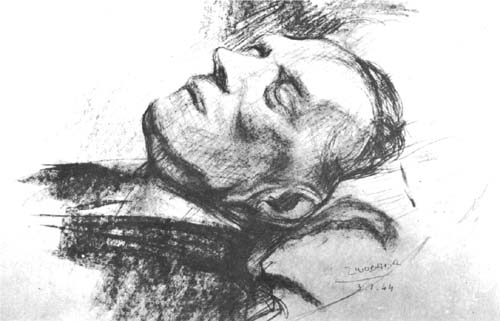
Jurgis Baltrušaitis Death mask drawn 3 January 1944.
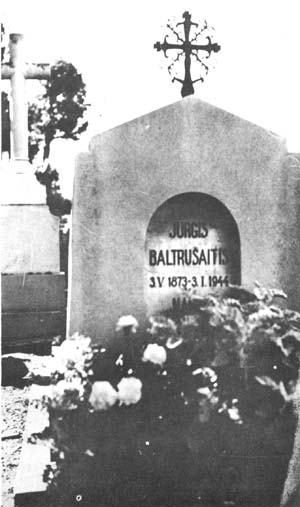
Jurgis Baltrušaitis Burried in Paris